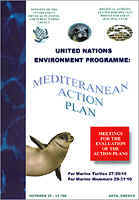 |
|
|
 |
||
 |
|
|
 |
||
UNEP/MAP Conference in Arta
As readers will no doubt have realised from our tongue-in-cheek Editorial – Navigating the Monk Seal Maze: A Guide for the Layperson – an international conference was convened in Arta, Greece, on 29-31 October to evaluate progress, and to identify additional priorities, in implementing Action Plans for the conservation of marine mammals as adopted within UNEP’s Mediterranean Action Plan.

Nineteen Contracting Parties were represented at the meeting – although it must be said that only a minority appeared to be particularly conversant with Mediterranean monk seals as a focus of discussion. This was regrettable, since an ideal opportunity to learn more from countries where question marks continue to hang over the status and conservation of the species was lost. This was especially true of Libya, Syria, Albania, Slovenia and Croatia. In other cases, presentations that raised particularly intriguing issues often provided inadequate details. Algeria, for example, noted that two national reserves – including two islands – had been established, although it remained unclear as to how these protected areas might benefit monk seals. Similarly, in reporting a number of recent seal sightings, Tunisia raised the possibility that the declaration of the species’ extinction in that country may have been somewhat premature. Again, we can only await further details and clarification with keen interest.
As is so often the case with official gatherings of this kind, breaks for coffee, lunch and dinner offered news of a far more interesting and candid nature than available in the prepared speeches and statements of the delegates. This was particularly evident in news emanating from Mauritania and the Western Sahara. Declaring that "the past is the past", Mauritanian officials announced that they would no longer tolerate internecine squabbling between foreign research and conservation teams operating in the country – a decision that will no doubt be warmly welcomed by anyone who places monk seals higher than personal ambition and ego.
Many participants, it seems, were also somewhat astonished to learn that a monk seal pup was undergoing rehabilitation in Mauritania, in an operation organised by the Spanish Monk Seal Project in association with the UK’s Royal Society for the Prevention of Cruelty to Animals (RSPCA). Although the animal had been rescued 6-9 months ago (depending on the origin of the rumour), this was apparently the first they had heard of the matter (See Regional News for further details).
As alluded to in our Editorial, UNEP/MAP rules of procedure meant that no official government representatives attended the meeting from either Madeira or Mauritania. Indeed, to all intents and purposes, for the Parties to the Barcelona Convention, the Mediterranean monk seal ceases to exist beyond the Straits of Gibraltar – a political reality whose existence was lucidly confirmed by the conference chair. Readers wishing to comment on this particular phenomenon, or to share their impressions of the Arta conference in more general terms, are kindly invited to address their letters to the editor@monachus.org.
Readers wishing to study the conference Recommendations, as finalised by the participants by the close of the meeting, should click on the following link: UNEP/MAP Conference Recommendations.
The Monachus Guardian hopes to publish the full proceedings of the conference – and related documents – as soon as they are made available by RAC/SPA. These will be available for online browsing or download in the Library of www.monachus.org.
Monk Seal Classic Online
 |
Iridescent Publishing has published six substantial extracts from The Monk Seal Conspiracy, a critically-acclaimed book of political intrigue and front-line conservation in the Eastern Aegean. The site can be found at http://www.iridescent-publishing.com. |
Has Anyone Seen a Caribbean Monk Seal?
The following item is excerpted from Circumstantial Evidence for the Presence of Monk Seals in the West Indies, which was published in the UK journal Oryx earlier this year…
"Based on interviews with 93 fishermen in northern Haiti and Jamaica during 1997 an assessment was made of the likelihood that monk seals survive in this region of the West Indies.
Fishermen were asked to select marine species known to them from randomly arranged pictures: 22.6 per cent (n=21) selected monk seals. This number was significantly (P < 0.001) greater than the number who selected control species (walrus, harbour seal, and sea-lion) that they were unlikely to have observed. However, it was not significantly different (n=19, P 0.1) from the number who selected manatees, which are known to occur in the region in small numbers. More than 95 per cent of respondents also identified species that are known to occur commonly in the region.
Further questioning of the 21 respondents who selected monk seals suggested that 16 (78 per cent) of them had seen at least one in the past 1-2 years. Those fishermen that were able to provide further descriptions gave information about size and colour that was consistent with many of these seals being monk seals. It is possible that the Caribbean monk seal is not extinct." – Ian L. Boyd, British Antarctic Survey, Natural Environment Research Council, Madingley Road, Cambridge CB3 0ET, UK.
Responding, Greg Early of the Edgerton Research Laboratory in Boston writes:
"Those interested in the above article may also wish to check the following website: http://www.tradewinds.vi/html/960909nc.html for an account of a hooded seal stranding in St. John’s (US Virgin Islands). Hooded and Harp seal strandings have increased greatly along the east coast of the US in the past decade.
Although this may be an isolated incident (and I have not seen the full text of the above article, and do not know if photos of juvenile harp and hooded seals were used in the investigation) sightings of extralimital arctic seals may account for at least some of the sightings of phocids in this area. – Greg Early, Edgerton Research Laboratory, New England Aquarium, Central Wharf, Boston, Mass 02110.
Mysterious ‘Marine Debris’ Discovered at French Frigate Shoals
Given the reluctance of some Hawaiian scientists to implicate – at least explicitly – dumped fishing gear in the continuing decline of Monachus schauinslandi [see Monachus in Monaco, The Monachus Guardian Vol. 1 No. 1], recent events at the north-western Hawaiian Islands may serve as a rather rude awakening.
According to the Associated Press, on 9 November the U.S. Coast Guard unloaded 6 tons of discarded fishing nets in Honolulu that had been collected during a cleanup of coral reefs near French Frigate Shoals in the Hawaiian Islands. The cleanup was a cooperative effort mounted by federal, state and private agencies. The National Marine Fisheries Service (NMFS), reported AP, ‘will work to identify the sources of net debris.’
Copyright © 1998 The Monachus Guardian. All Rights Reserved